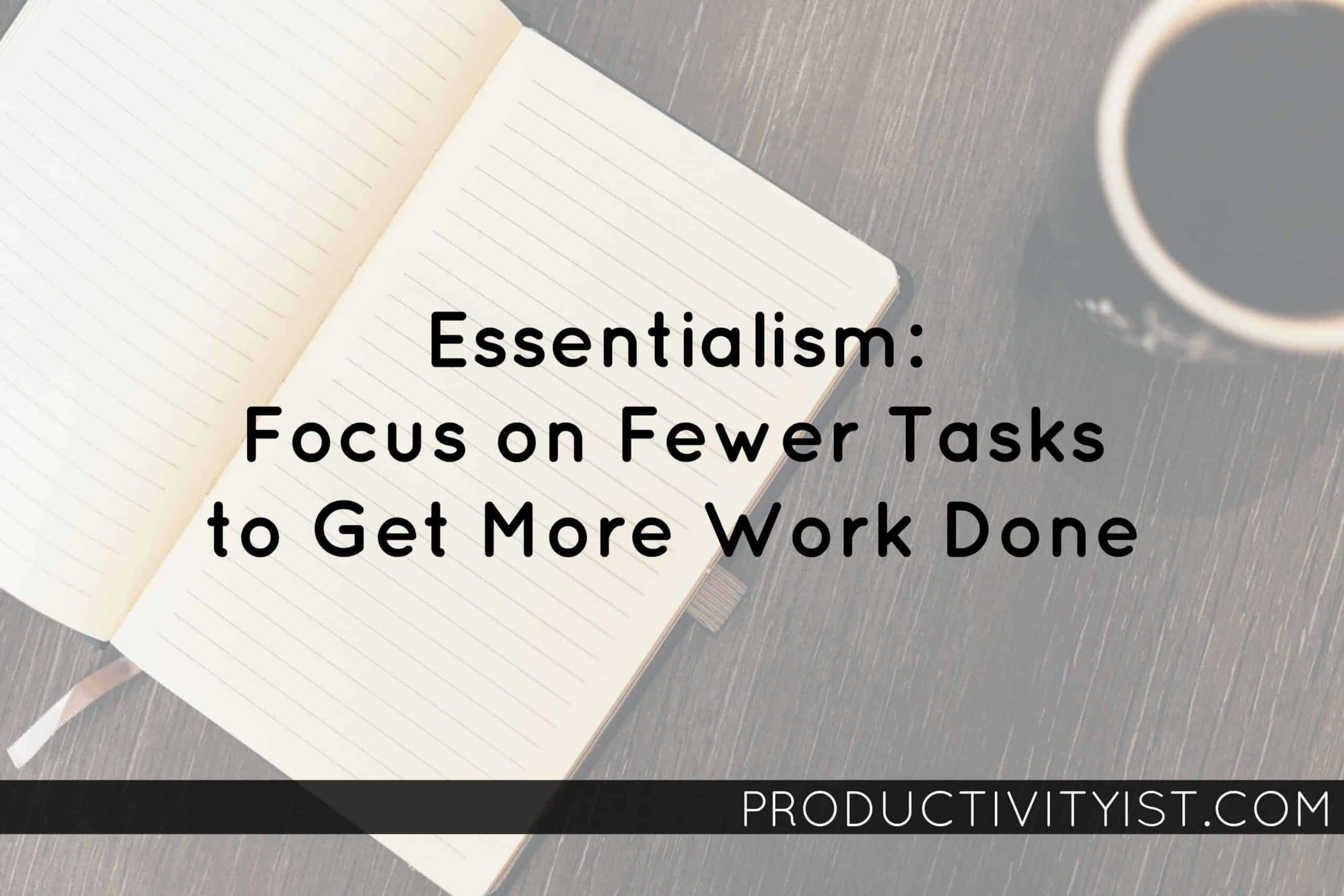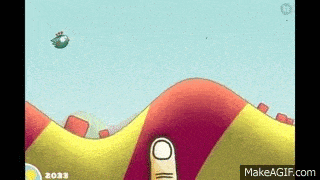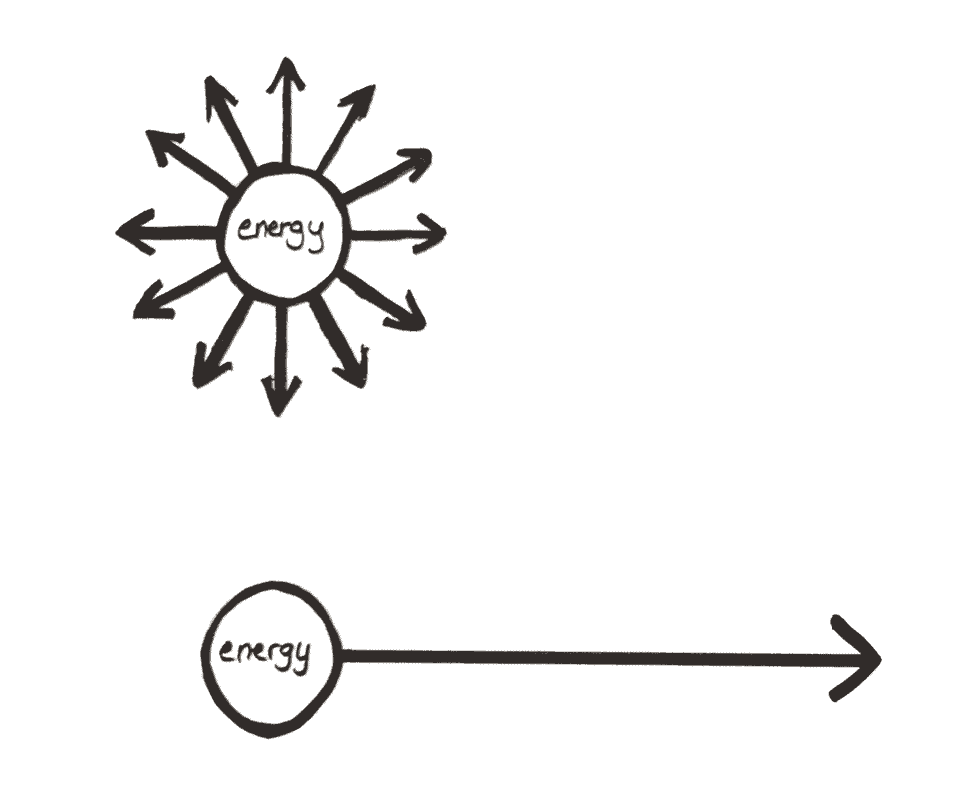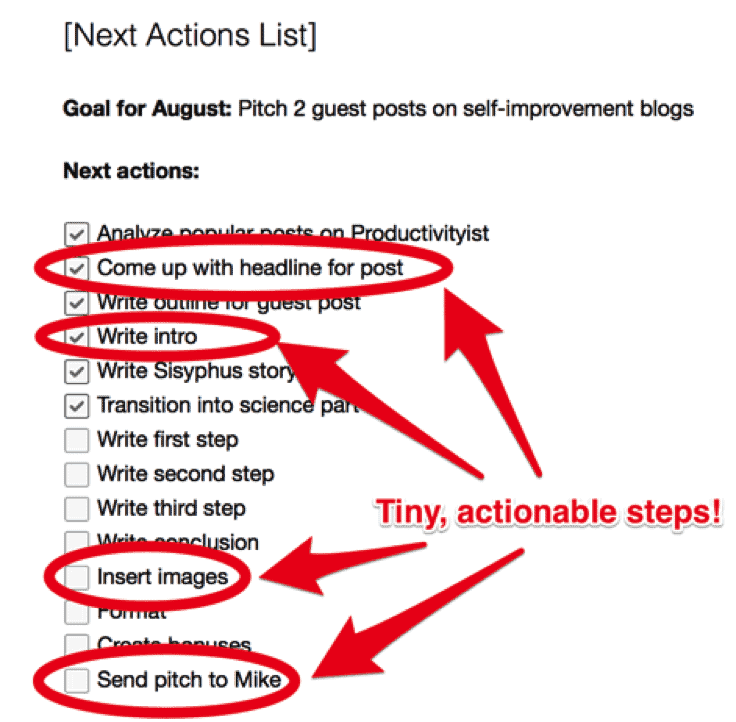This is a guest post by Niklas Goeke. Niklas is a freelance writer and coach on coach.me. Action is his cure to anything, so he won’t be mad at you if you cut some corners and jump right to the audiobook and video workshop version of this post.
Have you ever felt like there are just not enough hours in the day?
You feel like you’re rushing from one task to the next, but still do not catch up to a point where you feel good about the stuff you got done?
If you’re like me, you’ll often wonder why you don’t feel a sense of accomplishment at the end of the day, even though you’ve really given everything your best shot.
I’ll show you the two lessons that brought me on the essentialist path and how this can help you get things done with laser-like focus.
After implementing this, an item on your to-do list will look like this:
Looks pretty doable right?
Best of all, you’ll actually get it done, and generate momentum you can feel:
I wish I could take credit for this strategy, but unfortunately it’s simply the result of playing too many video games.
Yup. That’s right–video games. But before we dive into that, I have a disclaimer for you.
Note: This is a 2,600 word blog post. It has games, psychology, science, fun doodles, brain scans and technical step by step instructions. The whole nine yards. If you don’t want to spend a few minutes reading this, you can grab both the audiobook (yup, I read it for you) and the video workshop of how to implement this here.
You’re doing something wrong right now.
You’re doing it. Right now. I know you are.
And you don’t even realize it.
But it has to stop.
What do I mean?
Let your eyes wander to the top of the page. What do you see?
I see this:
Not one, not two, not three, but seven browser tabs are open in my browser right now.
How many are open in yours? Go ahead you can admit it.
How long have they been sitting on your screen? A day? A week? A few months?
I’m no saint. I do it just as much as you do.
I must admit I’m a multitasker.
Do you suffer from a chronic case of multitasking too?
Are the browser tabs just the tip of this sad iceberg of scattered attention?
It’s okay.
Come to think of it, it’s not okay; there is no doubt your performance suffers.
Every project you complete in multitasking-mode is punished with a loss of quality, loss of time and worst of all, you punish yourself with high levels of stress.
Don’t believe me? Think you’ve got it all under control?
Trust me, you don’t. I’ll show you.
Right here, right now.
Just play this game. I bet you won’t last a minute.
This game gives you different tasks, and as time goes by, more tasks are added. If you fail on any one task, you lose. There are up to four tasks, but as you can tell from my screenshot, I didn’t even make it that far.
What’s the first lesson to learn from this game?
You can’t multitask. If you tell yourself you can, you are lying to yourself.
Why is this game so hard? Is it the music? The balancing part? The up and down? The four directions?
Let’s take a look at what happens in your brain when you play it.
How multitasking affects your skill level
I don’t want to get into the nitty-gritty here, but I do want to give you the basics real quick.
When you single-task your brain lights up like this:
That’s because your both halves of your brain work together, setting off an anterior-to-posterior chain in your prefrontal cortex.
But when a second task is added, the right half of your brain takes care of the first task, while the left half takes care of the other. That means both sides now work independently, each chasing their own goal and reward.
What you have now is a brain that’s constantly switching between two different tasks. In an MRI, it would look more like this:
Instead of one brain, at full power, working on one task you now have two less powerful brain halves, spending shorter periods of time on more tasks.
Noticed something? There are only two halves of the brain, so what happens when you throw in a third task?
Right. It’s chaos.
When asked to do three tasks simultaneously, namely matching letters in sequence, case and color, participants of a research study continuously forgot one of the tasks, while producing three times as many errors on the two they were working on.
Multitaskers not only make more mistakes, they also complete tasks up to 40% slower than those who focus on just one task at a time.
This happens because your brain, like a computer processor, allocates time to each task. Whenever you switch tasks, the context has to be restored. This takes time, just like your computer has to load data from memory, update tables and render images each time you switch from one app to another.
As with interest in a bank, this time quickly compounds and makes you much less productive than if you just processed tasks in order.
Conclusion: The more time you spend working on one thing, the better your brain works, which leads to better results.
Video games the Essentialist way
Why do you think that game I just showed you was on a random webpage and not say an app or a proper video game?
Because it’s not fun. It’s hectic, stressful and overwhelming.
Here’s the story of a video game done right:
In February 2011, German game developer Andreas Illiger released Tiny Wings to the world.
The addictive game has sold over 10 million copies, making the shy one-man team behind it millions.
Zero budget. No marketing. No team. Just focus.
Andreas tried to make a game that even a one-and-a-half-year-old would enjoy.
Being a true essentialist, he focused on one single aspect during game development.
Andreas said “There are many destructive and negative games, so I wanted to figure out if it is possible to make a game which makes you feel happy.”
One-and-a-half-year-olds can’t multitask, so Andreas did everything to create a very simple game that would put them in a state of joy: beautiful and uplifting colors, a perky little main character, upbeat music and the simplest gameplay mechanism he could think of.
No complex leveling systems, no fancy graphics, he just absolutely nailed one of the three key components of gamification: motivation.
Intrinsic motivation drives the player towards internal rewards like enjoyment, positive feelings, and happiness. Each of these is found in Tiny Wings.
Here’s how the game works:
You’re a bird with tiny wings, who wants nothing but to fly sky high.
The only thing you have to do is press your finger to the screen to make the bird swoop down to use the next hill as a jump.
The gameplay gets faster as you play along, there are coins and and upgrades to collect.
But you as the player have just one task:
Swoop. Swoop. Again and again and again.
This makes the gameplay easier. Once you make some progress in the game, you’ll want to keep playing. It creates flow, a term coined by Mihaly Csikszentmihalyi. Flow is a state where your skill level and the level of the challenge match, so you neither get bored, nor frustrated.

That’s why it’s so addictive, and that’s the essentialist way.
Here’s the second lesson we can learn:
When you focus all your energy towards one thing, you’ll probably do a pretty good job at it.
Let’s see how these two lessons translate to your life and into a system you can use every day.
What does that have to do with your productivity?
I’m going to go out on a limb here and say this:
You lie to yourself too.
You trick yourself into believing things that just aren’t true.
For example, let’s say your to-do list looks like this:
- Take out the trash
- Work on client project
- Grocery shopping
- Lunch
- Answer emails
- Coaching
- Swimming
- Get a present for Mom & Dad
- Send out application for college
- Call the doctor
Yes? You did?
And, at the end of the day, did that to-do list end up like this?
The college application took way longer than expected – all day to be exact – so all you got around to doing after that was answering some emails and taking out the trash.
This is the MAJOR flaw with to-do lists.
You deceive yourself into thinking you actually know in advance how much you’ll be able to get done in a given day.
How to get stuff done the essentialist way
I’m sure you’ll agree that the example above is not the best way to go about organizing your day.
But you need some kind of structure on how you’ll spend your energy each day, so what to do?
Remember the lesson of Tiny Wings.
Spend all your energy on one thing and you are almost guaranteed to do an awesome job.
Single-tasking is all the hype in modern business books these days, and I suggest you start buying into it – because it works.
Let’s learn from a great essentialist.
In his book Essentialism, Greg McKeown presents two images, which make a significant case for single-tasking:
If your sleep schedule isn’t completely off, you have roughly sixteen waking hours each day. Let’s say you spend four hours taking care of yourself, eating, showering, walking, exercising, etc.
That leaves you with twelve hours to spend towards your goals. You could spend them like this:
Each arrow represents one hour of your time.
- You can spend one hour writing for your blog.
- One hour on social media promoting your stuff.
- One hour with billing and invoicing.
- One hour performing a service for a client.
- One hour calling and pitching a potential new client.
- One hour in a meeting.
- One hour just procrastinating and watching Youtube videos.
- One hour thinking about your long-term business strategy.
- One hour doing market research.
- One hour processing emails.
- One hour helping out your customers with questions.
- And one hour driving to and home from your office.
That’s a lot of stuff. And some days are like that.
But it never feels like you’re making progress.
Just for a second, imagine you would spend it like this:
What would happen, if you spent all twelve hours on one task?
Instead of writing for one hour, let’s just imagine you wrote for twelve hours. Even if you just wrote 500 words an hour, which is not too much, you’d end up with a massive 6,000 words!
Now that’s progress you can feel and see.
Most ebooks average around 25,000 words. You could write a book in four days.
That’s right, a whole ebook!
Of course twelve hours is a stretch, but even if you just spend eight hours doing the same thing – or even four or six hours – it’ll amount to something big, really, REALLY quickly.
Look at a comparison of the two ways:
Pretty obvious which option gets you from A to B faster, right?
When you are focused, the results will be exponentially better.
Alright, enough storytelling, doodling and scientific mumbo-jumbo, let’s take action!
3 steps to insane focus
Here are the three steps you need to take to create a single-item to do list for each day.
I like to do this in Evernote, but you can just as well do this in Trello, Wunderlist or even using pen and paper.
For my exact workflow in Evernote, grab the bonus video.
Step 1: Create a next actions list
The idea of a next actions list comes from David Allen’s book Getting Things Done and works like this:
You break down your big goal into tiny, actionable steps. Think of it as a recipe, that you can follow to the exact point, step by step.
For example, my goal for August is to successfully pitch two guest posts to other sites. This is how I broke it down:
You know you have good action items when each one takes 25 minutes or less.
Think simple – you want step-by-step instructions that a 4-year-old could follow.
Step 2: Pick your most important task for the next day
Gary Keller calls it ‘The ONE Thing.’ I like Leo Babauta’s approach, who calls it his M-I-T.
MIT stands for Most Important Task.
It’s memorable and if you’re like me, you like remembering things.
Pick one item off your next actions list. If you’ve done a good job at breaking your goal down you can just pick the next step from your instructions.
Write your MIT on a post-it note, make it bold and stand out. It will be your guide for the next 24 hours.

Note: It helps to set an alarm on your phone or inside Evernote, which rings tomorrow at the time you want to start work, for example 8 am, reminding you to look at your MIT first.
Step 3: Prevent distractions with a collection bucket
The third and last part of this system is called a collection bucket.
The only purpose of this is to serve as a bucket to collect all your random thoughts, distractions and interruptions.
You know what I’m talking about.
You’re productively typing away, when suddenly your phone vibrates.
Your partner or roommate texts you:
“Remember to bring some detergent!”.
“Alright,” you reply. You take a mental note and return to your task.
Bzzzzzz.
“I meant bleach.”
“Got it,” and then you return back to work.
Bzzzzz. Bzzzz.
“Sorry, I meant detergent after all.”
Sigh.
After the third or fourth interruption, even if you have the discipline to get back on task, your head will be buzzing with thoughts.
That detergent will keep nagging at you, making it impossible for you to focus.
You have to get these thoughts out of your head.
That’s the magic of the collection bucket.
Take every distraction, interruption, text, email, notification, – even all the things that you suddenly remember during a break – and jot them down in your collection bucket.
How to use this system for maximum productivity
Tomorrow morning, when your alarm rings and you’re about to start work, look at your most important task again.
Then set a timer for 25 minutes and get started.
(I like using this one, but you can also just use your phone)
For all arising distractions, be it external or your own thoughts, go to your collection bucket and jot them down – you can take care of these things later.
Should you, for some reason, not be able to finish your MIT in 25 minutes, take a five minute break.
Anything is fair game – except for work.
Walk the dog, sweep the yard, do some squats, run around the block, just get up and moving and do something not work-related.
After another 25 minute block you should definitely be done, otherwise you need to rework your next actions list.
Recap: 3 Steps to Insane Focus
We just covered a whole lot of ground, so let’s recap the 3-step-process:
Step 1: Create a next actions list, where you break down your project into tiny action items that take 25 minutes or less
Step 2: Pin down one of your next action items as tomorrow’s most important task
Step 3: Set up a collection bucket to quickly deflect all incoming distractions – even your own thoughts
The beauty of this system is it generates tons of momentum. I started with an outline today, and am now typing the last few words of this 2,000+ word blog post, just five hours later.
To help you implement this as fast as possible, I’ve created an essentialist bonus package, including:
- the audiobook version of this post
- 1,000+ word report on the science behind multitasking
- a video workshop where I cover my entire workflow in Evernote
You can grab those bonuses here.
This post was written using the exact strategies presented in it, which was a lot of fun!
“Remember that if you don’t prioritize your life, someone else will.” – Greg McKeown author of Essentialism














